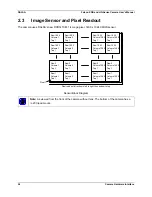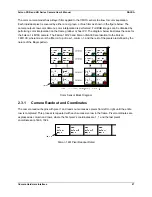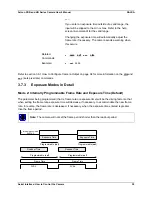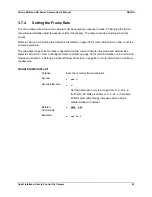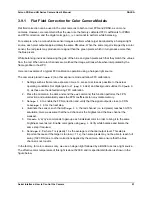
Falcon XDR and HG Series Camera User's Manual
DALSA
Serial Interface: How to Control the Camera
37
In non-concurrent mode, a low-to-high transition in the EXSYNC signal starts the integration time, and a
high-to-low transition in the EXSYNC signal starts the readout of image data. This is the same as in
concurrent mode. The difference between these two modes is that you do not perform your next low-to-
high transition of EXSYNC until readout has completed. The Waiting period can be reduced to 0 seconds
by starting the low-to-high transition immediately after readout is complete. The readout time is a fixed
amount of time that is dependant upon the mode of operation of the camera, but is typically around
10.0ms.
3.7.2
Setting the Exposure Mode and Time
You have a choice of operating in one of the following exposure modes.
Mode
EXSYNC Programmable
Frame Rate
Programmable
Exposure Time
Description
Concurrent/
non-
concurrent
operation
2
Internal
Yes
Yes, minimum
40
µ
s
Internal frame rate and
exposure time.
Both
4
External
No
No, minimum
40
µ
s
Smart EXSYNC. High
time is the exposure
time.
Both
6
External
No
Yes, minimum
40
µ
s
Falling EXSYNC initiates
integration. Exposure
time is programmed into
the camera.
Both
9
External
No
No, minimum
10
µ
s
Smart EXSYNC. High
time is the exposure
time.
Non-
concurrent
only
10
External
No
Yes, minimum
10
µ
s
Falling EXSYNC initiates
integration. Exposure
time is programmed into
the camera.
Non-
concurrent
only
Summary of Contents for Falcon 1.4M100 HG Monochrome
Page 28: ...DALSA Falcon XDR and HG Series Camera User s Manual 28 Camera Hardware Interface ...
Page 70: ...DALSA Falcon XDR and HG Series Camera User s Manual 70 Optical and Mechanical Considerations ...
Page 74: ...DALSA Falcon XDR and HG Series Camera User s Manual 74 Troubleshooting ...
Page 90: ...DALSA Falcon XDR and HG Series Camera User s Manual 90 Appendix C EMC Declaration ...
Page 92: ...DALSA Falcon XDR and HG Series Camera User s Manual 92 Technical Support ...




